The Pale Chanting Goshawk (Melierax canorus) commands attention with its charismatic presence in the arid landscapes of southern Africa.
As a member of the Accipitridae family, this raptor is renowned for its distinctive vocalizations, characterized by melodious chants and whistles.
A medium-sized bird of prey, it exhibits a robust build with broad wings and striking red eyes, adding to its captivating allure.
Thriving in arid and semi-arid environments, the Pale Chanting Goshawk showcases remarkable adaptability, soaring over open habitats and perching on elevated vantage points.
Its pale coloration, monogamous pair bonds, and adept hunting strategies contribute to the species’ unique ecological niche.
Studying the Pale Chanting Goshawk unveils not only the intricacies of its behavior and habitat preferences but also emphasizes the significance of conservation efforts to preserve this fascinating raptor and its role in maintaining the ecological balance of its native regions. Stay sharp.
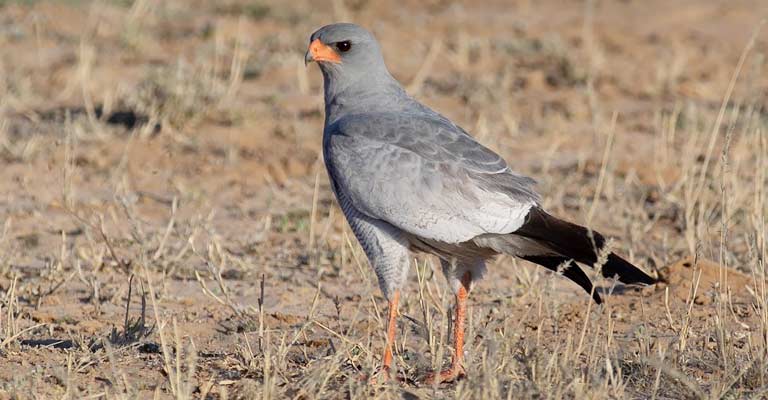
Physical Characteristics of Pale Chanting Goshawk
The Pale Chanting Goshawk (Melierax canorus) is a distinctive bird of prey native to the arid regions of southern Africa.
Its physical characteristics make it easily identifiable, and here are eight key points to help you recognize this fascinating raptor.
Size and Shape
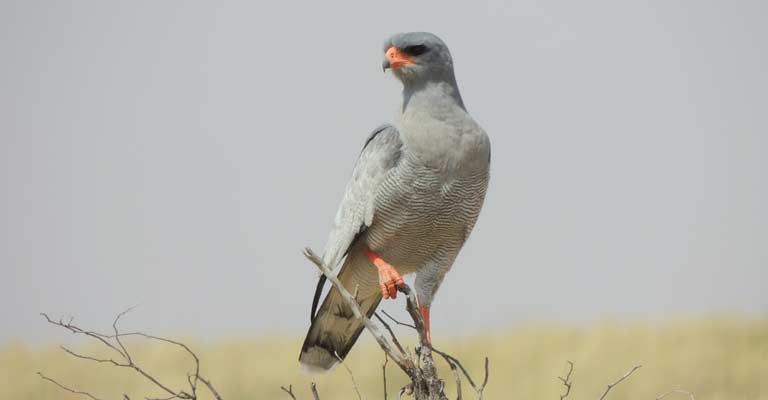
The Pale Chanting Goshawk is a medium-sized bird with a length ranging from 18 to 24 inches (45-60 cm). It has a robust build, characterized by broad wings and a relatively short tail.
The wings are well adapted for soaring, and the bird’s overall shape is designed for efficient flight in open habitats.
Coloration
As the name suggests, the Pale Chanting Goshawk exhibits a predominantly pale coloration.
The upperparts are light gray to sandy brown, with a paler head and neck. The underparts are generally white with fine brown streaks. The eyes are a striking red, adding a contrasting element to its overall appearance.
Head and Facial Features
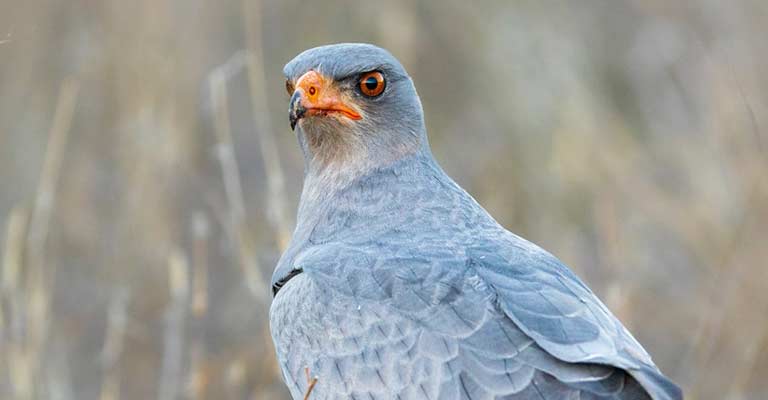
The head of the Pale Chanting Goshawk is relatively small in proportion to its body, and it features a distinctive facial mask.
This mask is characterized by dark markings around the eyes, giving the bird an intense and focused expression. The hooked beak is powerful and adapted for tearing into prey.
Flight Pattern
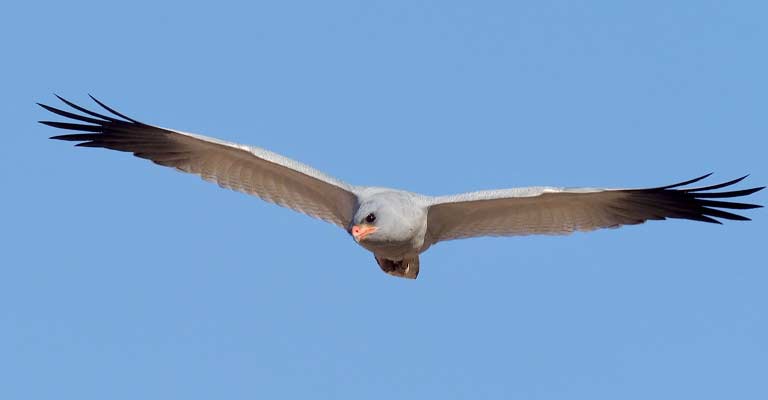
When in flight, the Pale Chanting Goshawk displays a distinctive soaring pattern with its wings held in a slight dihedral position.
The broad wings and short tail contribute to its agile flight, and observers can notice its effortless gliding as it scans the ground for potential prey.
Habitat Preference
This bird is commonly found in arid and semi-arid regions, including savannas, grasslands, and desert areas.
It avoids dense forests and is often spotted perched on elevated vantage points such as trees or poles, providing an excellent vantage point for hunting.
Vocalizations
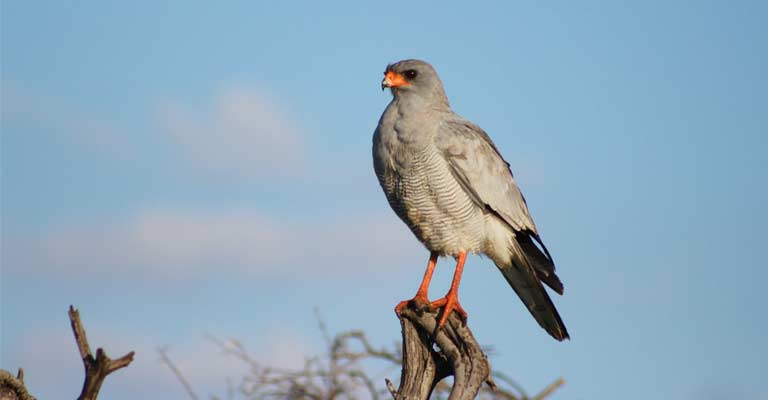
The Pale Chanting Goshawk is known for its distinctive vocalizations, which include a series of melodious whistles or “chants.”
These calls are often used to communicate with mates or establish territory. The vocalizations can be a helpful clue in identifying the bird’s presence in an area.
Behavioral Traits
This goshawk is an adept hunter, preying on a variety of small mammals, birds, and insects.
Its hunting strategy often involves patiently perching and scanning the surroundings before swooping down to catch its prey.
This behavior, combined with its distinctive appearance, helps in distinguishing it from other raptors.
Distribution
The Pale Chanting Goshawk is primarily found in the southern regions of Africa, including countries like South Africa, Namibia, Botswana, and Zimbabwe.
Its distribution is closely tied to the availability of suitable open habitats for hunting.
The Pale Chanting Goshawk’s unique combination of size, coloration, facial features, flight pattern, habitat preference, vocalizations, behavior, and distribution make it a fascinating bird to identify and observe in the diverse landscapes of southern Africa.
Taxonomy of Pale Chanting Goshawk
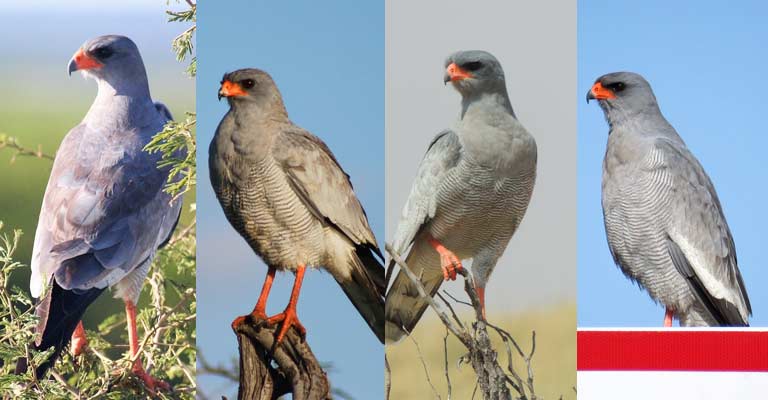
Here is a table outlining the taxonomical details of the Pale Chanting Goshawk:
| Taxonomic Level | Classification |
| Domain | Eukaryota |
| Kingdom | Animalia |
| Phylum | Chordata |
| Class | Aves |
| Order | Accipitriformes |
| Family | Accipitridae |
| Genus | Melierax |
| Species | M. canorus |
The Pale Chanting Goshawk, scientifically known as Melierax canorus, belongs to the Accipitridae family. This family includes various species of birds of prey characterized by strong talons and hooked beaks.
Within the genus Melierax, the Pale Chanting Goshawk is distinguished by its unique features, such as its pale coloration, distinctive vocalizations, and adaptations to arid environments.
While taxonomically related to other goshawks, the Melierax canorus species is particularly known for its presence in the arid landscapes of southern Africa, showcasing a specialized niche in this region’s ecosystems.
Pale Chanting Goshawk Life History
The Pale Chanting Goshawk (Melierax canorus) is an intriguing bird of prey native to the arid landscapes of southern Africa.
Its life history is marked by unique adaptations and behaviors that contribute to its survival in challenging environments.
In this comprehensive exploration, we delve into various aspects of the Pale Chanting Goshawk’s life, range map, nesting behaviors, breeding strategies, susceptibility to diseases, treatment considerations, and conservation status.
Food
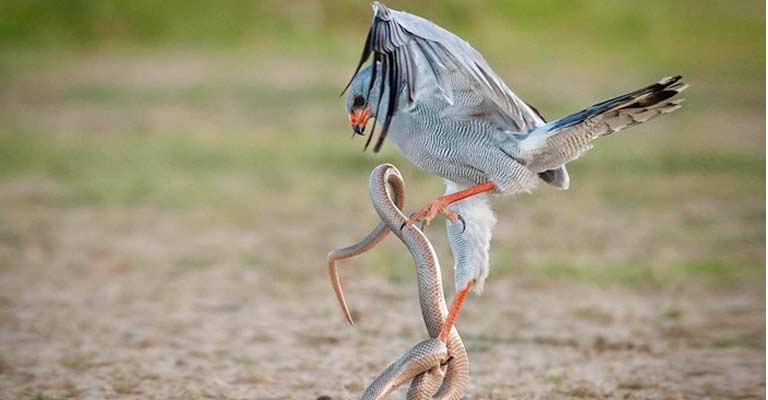
The Pale Chanting Goshawk is a carnivorous raptor with a diverse diet. Its primary food sources include small mammals, birds, reptiles, and insects.
This adaptable hunter often employs perching as a strategy, patiently waiting for prey before swiftly descending to catch it.
The goshawk’s powerful beak and talons facilitate the tearing and consumption of a variety of prey items, reflecting its role as a versatile predator in its ecosystem.
Habitat
This species thrives in arid and semi-arid habitats such as savannas, grasslands, and open woodlands. It avoids dense forests and prefers elevated perches, which provide optimal vantage points for hunting.
The bird’s ability to adapt to different arid environments underscores its resilience in the face of challenging conditions.
Range Map
The Pale Chanting Goshawk’s distribution spans across the southern regions of Africa, encompassing countries like South Africa, Namibia, Botswana, and Zimbabwe.
A detailed range map illustrates its presence in specific ecosystems, highlighting the bird’s adaptability to varying geographical and environmental conditions within its range.
Nesting
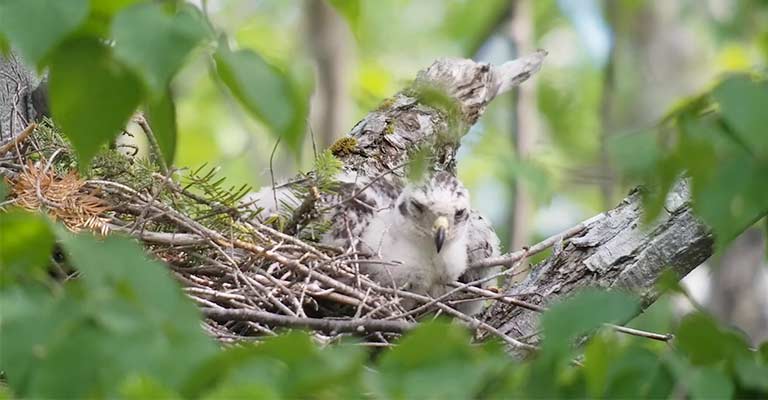
Nesting behaviors are crucial aspects of the Pale Chanting Goshawk’s life history. These raptors construct nests in trees or on cliffs, utilizing sticks, twigs, and other materials to create a sturdy platform.
The choice of nesting sites often aligns with their preference for elevated positions, offering both protection and an advantageous viewpoint for monitoring their surroundings.
Here’s a table summarizing the nesting details of the Pale Chanting Goshawk:
| Nesting Details | Facts |
| Clutch Size | 1 to 3 eggs |
| Number of Broods | Typically 1 per breeding season |
| Egg Length | Approximately 53-58 mm |
| Egg Width | Approximately 40-45 mm |
| Incubation Period | Around 38 to 42 days |
| Nestling Period | Approximately 40 to 50 days |
| Egg Description | Pale bluish-white with some brown spots |
| Nesting Site | Trees or cliffs, constructing a platform |
| Nest Construction | Sticks, twigs, and other plant materials |
| Parental Involvement | Both parents participate in incubation |
| Courtship Displays | Aerial displays and vocalizations |
These details offer insights into the reproductive behavior of the Pale Chanting Goshawk, highlighting the species’ nesting preferences, egg characteristics, and parental involvement during incubation and nestling care.
Breeding
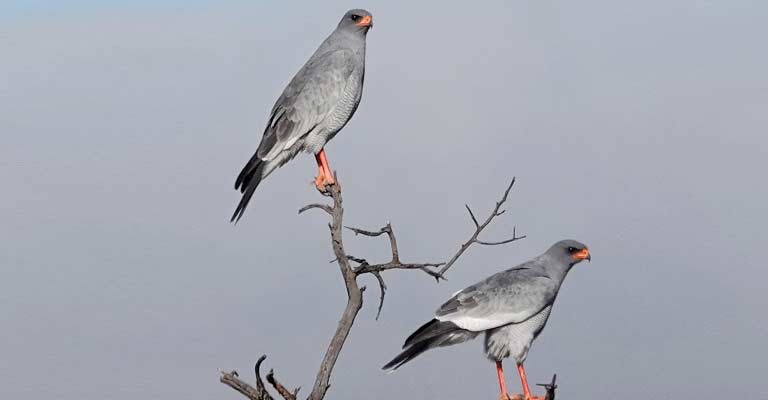
Breeding in Pale Chanting Goshawks typically occurs during the dry season. Courtship involves aerial displays and vocalizations, reinforcing pair bonds.
The female lays a clutch of eggs, and both parents share responsibilities in incubation and chick-rearing.
This collaborative effort enhances the chances of offspring survival in the demanding arid environment.
Diseases
While the Pale Chanting Goshawk does face threats from various diseases, their specific vulnerabilities are not extensively documented.
Common avian ailments, such as parasites and respiratory infections, may affect individuals. Monitoring and understanding the health of these birds contribute to their overall conservation.
Treatment
In cases of disease or injury, rehabilitative efforts may involve expert veterinary care. Addressing injuries, administering medications, and managing stress are vital components of effective treatment.
Conservation organizations may play a role in supporting these interventions to ensure the well-being and survival of individual birds.
Conservation
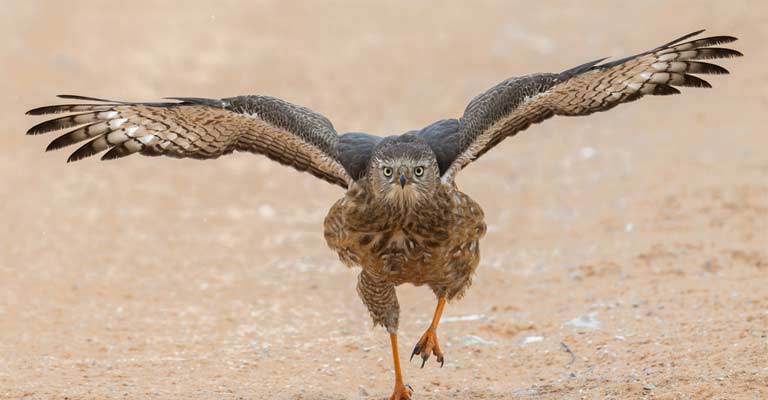
The conservation status of the Pale Chanting Goshawk emphasizes the importance of preserving its arid habitat.
Threats such as habitat loss, climate change, and human disturbances impact their populations.
Conservation initiatives include habitat protection, research, and education to promote awareness and sustainable coexistence.
The life history of the Pale Chanting Goshawk unfolds as a remarkable story of adaptation and survival in the challenging landscapes of southern Africa.
Understanding and safeguarding this species contribute not only to the conservation of a unique raptor but also to the broader ecological balance of its arid habitats.
10 Fun Facts About Pale Chanting Goshawk
The Pale Chanting Goshawk (Melierax canorus) is a captivating bird of prey native to the arid landscapes of southern Africa. Here are 10 fun facts about this remarkable raptor:
- Distinctive Vocalizations: The Pale Chanting Goshawk is known for its melodious and repetitive vocalizations, which include whistles and chants. These calls are not only distinctive but also serve as a means of communication between individuals.
- Red-eyed Stare: One of the most striking features of this goshawk is its intense red eyes. The vivid coloration adds a mesmerizing and fierce quality to its overall appearance, enhancing its predatory allure.
- Arid Habitat Specialist: Unlike many raptors, the Pale Chanting Goshawk thrives in arid and semi-arid environments. Its adaptability to these challenging habitats showcases its resilience and specialized hunting strategies in regions with limited resources.
- Versatile Diet: These goshawks are opportunistic hunters with a diverse diet. From small mammals and birds to reptiles and insects, their versatile palate reflects their adaptability to different prey items available in their arid ecosystems.
- Adept Hunter in Flight: With broad wings and a short tail, the Pale Chanting Goshawk exhibits exceptional agility in flight. It soars over its open habitat, using its keen eyesight to spot potential prey before making a swift descent for the capture.
- Nesting Platform Construction: These birds construct nests on elevated platforms in trees or on cliffs. They utilize sticks, twigs, and plant materials to create a sturdy foundation, showcasing their resourcefulness in nest construction.
- Monogamous Pairs: Pale Chanting Goshawks are known to form monogamous pairs during the breeding season. These pairs engage in courtship displays, including aerial acrobatics and vocalizations, reinforcing their bond.
- Excellent Vision: The goshawk possesses exceptional vision, allowing it to spot prey from great distances. This visual acuity is a crucial adaptation for hunting in the expansive open landscapes where it resides.
- Adaptation to Human Presence: In some regions, Pale Chanting Goshawks have adapted to human presence, often perching on telephone poles or other man-made structures. This adaptability showcases their ability to coexist with changing landscapes.
- Conservation Concerns: While not currently considered globally threatened, habitat loss due to human activities poses a potential threat to the Pale Chanting Goshawk. Conservation efforts are essential to ensure the continued survival of this unique species in its arid habitats.
These fun facts shed light on the intriguing characteristics and behaviors of the Pale Chanting Goshawk, making it a fascinating subject for bird enthusiasts and nature lovers alike.
Wrapping Up
The Pale Chanting Goshawk stands as a testament to nature’s adaptability and beauty.
From its distinctive vocalizations to its adept hunting strategies, this raptor showcases a unique blend of characteristics that define its life in the arid landscapes of southern Africa.
Its red-eyed stare, monogamous pair bonds, and versatile diet add layers to the fascinating narrative of this bird of prey.
As conservation efforts become increasingly crucial, understanding and appreciating the Pale Chanting Goshawk’s role in its ecosystem becomes paramount for the preservation of its specialized habitats and the broader biodiversity of the region. Stay focused.